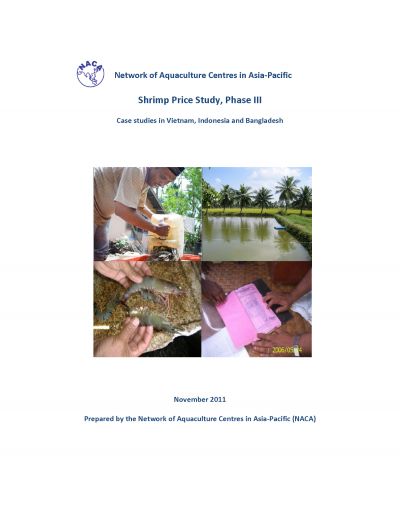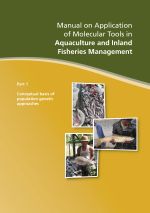Shrimp price study, phase III: Case studies in Vietnam, Indonesia and Bangladesh
2 December 2011 | 2690 Downloads | .pdf | 5.93 MB | Shrimp, Bangladesh, Indonesia, Vietnam, Markets and trade
This study is a continuation of “Evaluation of the impact of the Indian Ocean tsunami and US antidumping duties on the shrimp farming sector of South and South-East Asia”, a study conducted by Network of Aquaculture Centres in Asia-Pacific (NACA) in 2006, with the aim of assessing the impact of the 2004 Indian Ocean tsunami and of the introduction of anti-dumping duties on the shrimp farming sectors of countries in the Asian region, with special focus on the effect that these unforeseen events had on shrimp prices and livelihoods of the stakeholders. The project was conducted in three countries selected as representatives for countries affected by the anti-dumping duties, the tsunami, and neither event respectively.
The first-round study, while giving an insight on the impact of the Indian Ocean tsunami and US antidumping, also highlighted the need for continuous collection of price data from a wider range of stakeholders in the supply chain in order to do a thorough evaluation of the health of the industry and to identify the interventions to be made to increase the sustainability of the sector. Phase II (January 2008 to June 2009) and Phase III (Current study) are follow-up studies based on the recommendations derived from the initial study. The present study is the 3rd phase of this extended study and aims to update the social and economic trends in the shrimp farming sector investigated during the previous phases.
This report is based on the data collected from the 3 representative countries, Vietnam, Indonesia and Bangladesh from July 2009 - November 2010. The sampling locations and methods were kept identical as far as possible to those adopted in the previous studies, enabling valid data comparisons and analysis.
Investment levels of the Vietnamese farmers were either stable or slightly increasing over the study period due to improvement of technical skills and management tools. Consequently, both the total production of shrimp harvested per year and shrimp yield per crop remained stable. The price of the shrimps was determined by the size and seasonal crop, and has tended to increase rapidly between 2008 and 2009, especially for bigger size for both P. monodon and P. vannamei. About 85% of the respondents were aware of US anti-dumping in 2004, and it was this was thought to be the reason for decreased shrimp prices. However, in general shrimp farmers, traders and processors/exporters who were impacted by the US antidumping duties have tried to find strategies to mitigate these negative impacts by finding ways to reduce production and marketing costs, improve shrimp quality, and increase the proportion of value added products for export.
A number of significant changes in shrimp farming industry were apparent in Indonesia over the past few years. The yield of the first crop showed a 35% increase in 2010 compared with 2009. Although tiger shrimp remained the most important traded commodity, the traded amounts of both this species and white shrimp other than P. vannamei decreased over time, while P. vannamei trading appeared to be still on top. In contrast with the rapid increase evident in Vietnam, Indonesian shrimp prices for most count sizes of P. monodon and for most stakeholder groups were slightly fluctuating over the study period. Sales prices by farmers also have randomly fluctuated overtime whilst procurement prices by traders tended to increase toward end of the year with highest price recorded in January 2010. A majority of farmers and traders were aware of the occurrence of the tsunami in December 2004, but only of them were conscious about its impact on their business. Most processors said that their business mainly affected by scarcity of shrimp volume from aquaculture and government ban of shrimp trans-shipment. Other difficulties associated with Indonesian shrimp industry were endemic disease outbreaks and increasing pressure from international markets requesting quality products. In Bagladesh, P. monodon remained the major common traded commodity ranging from 77- 98% during 2010. Volume of P. monodon trade showed a slight increase from 2009 to 2010. Trends of both procurement as well as resale prices of all the concerned stakeholders were positive indicating that over time both increased. 100% percent of the traders and the majority of the depot owners, agents and processors replied that the price of shrimp was higher in 2010 than in 2009 and the price increase helped expand the businesses of many stakeholders. Majority of the farmers were unaware of the tsunami however the rest in the chain, from traders to processors were. Farmers, traders and depots claimed that the tsunami did not affect their livelihood but Sidr (2007) and Aila (2009). Agents and processors claimed that imposing of non-tariff barriers had adverse effects on shrimp exports in 2008. Most of the stakeholders are also concerned about the climate change effects. Only the processors were aware of the US anti-dumping and have identified some indirect effects of it on the industry. In general, livelihoods were not directly affected by the tsunami and US anti-dumping.
In conclusion, shrimp farming sector has influenced by many factors over the past few years such as unforeseen natural events, international trade barriers and increasing consumer demand for good quality products. Mitigatory and recovery methods identified and implemented by some counties have been effective in remaining stable amid such difficulties. However, the results of the study made clear the importance of having sound mitigatory and recovery strategies and good marketing strategies while taking steps to improve the quality of the products by introducing better management practices to ensure sustainability of the trade.
Publisher: Network of Aquaculture Centres in Asia-Pacific
Rights: Creative Commons Attribution.

